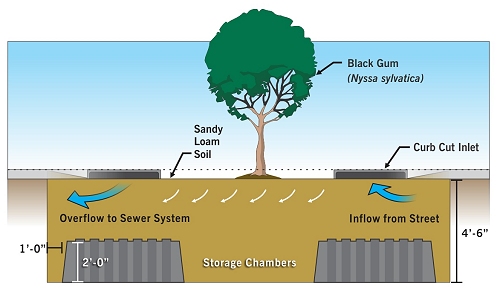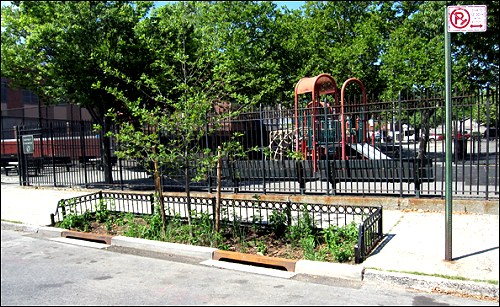Park Chelsea is Green Infrastructure
that can help save NYC Millions of dollars
At 25th St and the Hudson River raw sewage is dumped when our combined sewer outlets (CSO's) are overwhelmed by rainfall (Kayaking occurs within a few blocks of this point)
"The success of the Green Infrastructure Plan depends on support from local communities to help us develop innovative ways to deal with stormwater where it falls — not after it enters the sewer system, where it can impair water quality," said Commissioner Holloway...
"The NYC Green Infrastructure Plan will improve harbor water quality by capturing and retaining stormwater runoff before it enters the sewer system. Most green infrastructure uses natural features, like green-roofs, and adds structural designs, like porous pavement and tree pits, to absorb and retain stormwater. By replacing the current "grey" strategy with the Green Infrastructure Plan, the City will cut CSOs by more than 12 billion gallons per year by 2030 — a 40% reduction — which is two billion gallons more per year than the under the current plan. The Green Infrastructure Plan will cost New Yorkers $2.4 billion less than the tanks and tunnels that we are currently required to build. " Link
Using Green Infrastructure to Manage Stormwater
"To implement this Green Infrastructure Plan, the City is prepared to spend up to $1.5 billion over
20 years, including approximately $187 million in capital funds over the next four years, to build
green infrastructure." Page 11 NYC Green Infrastructure Plan
Sewers can also become overtaxed during intense rain events when the sheer volume of stormwater and wastewater entering the system fills them to capacity, leaving no space for excess water to enter. In this condition, described as a sewer being surcharged, the excess stormwater remains above ground. Unless absorbed by green spaces or channeled to a body of water, this flooding can flow off the street into below-grade areas such as driveways, patios and basements.
link
"Runoff from the street is diverted by curb cut
and routed into this enhanced tree pit, where specially engineered soils
and native plant species are used to absorb water and filter associated
pollutants. In some enhanced tree pits, storage chambers hold
additional runoff, available for plant uptake or groundwater recharge"


One inch of rain falling on the street and sidewalk of a typical Chelsea block can produce 6,500 gallons of stormwater runoff. A Park Chelsea micropark can treat over one inch of
stormwater runoff from a 1,530 square foot area of the street and
sidewalk amounting to 954 gallons Link
A combination of Park Chelsea's microparks and enhanced tree pits can make a significant dent in Chelsea's CSO problem.
http://new-york-jfk.airports-guides.com/jfk_climate.htmlAs this chart shows there are roughly 120 days of precipitation per year resulting in 47 inches of rainfall. This amounts to approximates 4/10 of an inch of rain on days that rain. I will assume that on most days of rain our CSO system is able to handle the precipitation. On the days that we had an inch of rain if every block in Chelsea had a combination of seven microparks/enhanced tree pits than an inch of rain could be treated.
the cost of installing and maintaining these seven microparks/enhanced tree pits will be a fraction of the cost of building the equivalent in mechanical sewage treatment facilities.

While the Columbus Avenue bioswale’s performance during stormy weather has yet to be assessed, the DEP said that their bioswales (they warned that the building specifications, and therefore performance, of other bioswales may vary) soak up 2,244 gallons during storms.
link



No comments:
Post a Comment